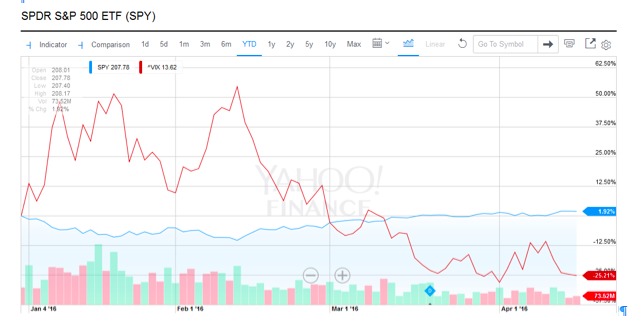The S&P 500 index returned +1.35% in Q1-2016 compared to +0.80% in the same quarter last year. The manic depressive behavior during the first quarter caught many investors by surprise.
The first half of the quarter was marked by extreme pessimism (high VIX volatility) and the market cratered over 10%.
Then in dramatic fashion, Mr. Market’s mood swung to gleeful optimism (low VIX volatility), which catapulted the S&P 500 to end the quarter up 1.35%!

Mood Swings
Benjamin Graham’s (father of value investing) allegorical Mr. Market is often identified as having human behavioral manic-depressive characteristics, it:
- Is emotional, euphoric, moody
- Is often irrational
- Offers that transactions are strictly at your option
- Is there to serve you, not to guide you.
- Is in the short run a voting machine, in the long run a weighing machine.
- Will offer you a chance to buy low, and sell high.
- Is frequently efficient…but not always.

Microsoft
During market pessimism earlier on in the quarter, I added to our American Express (AXP) position.
Conversely, as the market rebounded on optimism, I reduced our position in Microsoft (MSFT).
It’s also worthy to note that our position in Yahoo (YHOO) is currently in play as activist investors are pushing for change due to lackluster results at its core business in display and search advertising.
Strategic Options
As a result, Yahoo is currently evaluating it strategic options, including a reverse spin-off of its non-Alibaba holdings and a sale of its core business.
According to sources familiar with the matter, Verizon (VZ) looks to be the favorite to win the bid as they appear most interested and therefore likely to offer the most premium for Yahoo’s core business.
Additionally, Verizon has already shown their willingness to acquire internet companies when they acquired AOL for a cool $4.4 billion last year. Stay tuned!
Wall of Worry
As we enter the second quarter, I remain cautiously optimistic as the market continues to climb the wall of worry.
And there is plenty to worry about, including a global slowdown, high valuations and central banks resorting to zero interest rates ZIRP and negative interest rates (NIRP).
With respect to persistent ZIRP and NIRP, Japan’s experience with two decades of near-zero (and now negative) interest rates offers an example of how bad things can get for the rest of the world.
Photo Credit: Jessica Keating via Flickr Creative Commons


